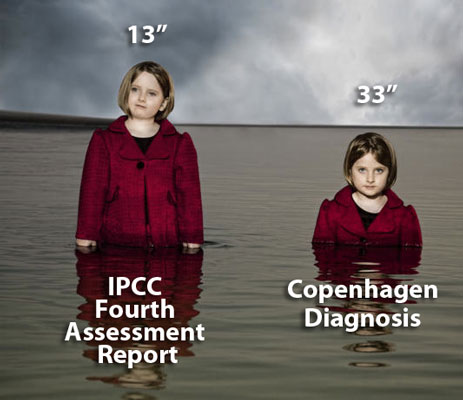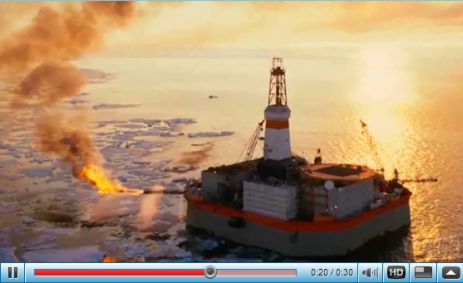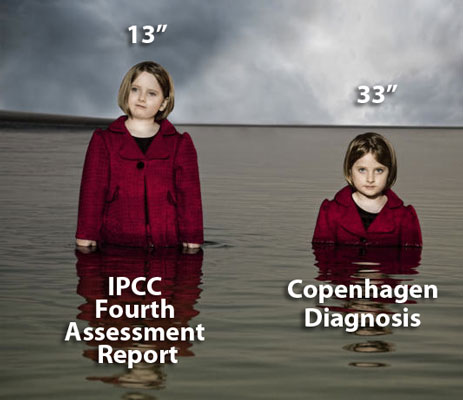 The IPCC’s prediction for average sea-level rise this century is 13 inches (if global warming continues unchecked). Today’s report from a group of climatologist ups the prediction to 33 inches. This is what the difference looks like on a pair of identical twins. Photo Illustration courtesy Greg Ceo.The Intergovernmental Panel on Climate Change — the world’s foremost body for weighing and assessing climate science — received a kick in the pants today from members who say the climate situation is much worse than the IPCC has so far reported.
The IPCC’s prediction for average sea-level rise this century is 13 inches (if global warming continues unchecked). Today’s report from a group of climatologist ups the prediction to 33 inches. This is what the difference looks like on a pair of identical twins. Photo Illustration courtesy Greg Ceo.The Intergovernmental Panel on Climate Change — the world’s foremost body for weighing and assessing climate science — received a kick in the pants today from members who say the climate situation is much worse than the IPCC has so far reported.
Twenty-six climatologists — including 14 IPCC members — have released a startling update to the panel’s work, reporting that sea levels could rise and methane-laden arctic permafrost could melt much sooner than the panel had anticipated.
“The Copenhagen Diagnosis: Updating the World on the Latest Climate Science” is not an official IPCC report; it’s a summary of the hundreds of peer-reviewed research papers that have been published since the IPCC’s last assessment. It was released now to fill the long gap in between official IPCC reports — the last was released in 2007, but the drafting text is more than three years old, and the next isn’t scheduled until 2013. It was also timed to the Copenhagen climate talks, of course.
The essence of the new report is that things are grimmer than the IPCC has reported. And it’s not like the panel has been painting a rosy picture — its 2007 report concluded that the warming-induced melting of the Greenland ice sheet could create significant sea-level rise in this century. IPCC chairman Rajendra Pachauri said at the time, “If there’s no action before 2012, that’s too late. What we do in the next two to three years will determine our future. This is the defining moment.”
The new diagnosis finds that arctic sea ice is melting 40 percent faster than the panel estimated just a few years ago. Another startling finding: Satellites have found that the global average for rising sea levels was 3.4 millimeters per year from 1993-2008. The IPCC estimated it would be 1.9 mm for that period — short by 80 percent.
The report’s authors (who include the preeminent Stephen Schneider) write that “if global warming is to be limited to a maximum of 2°C above pre-industrial values, global emissions need to peak between 2015 and 2020 and then decline rapidly.” If you’re keeping score, 2015 is just over five years away — somewhat less comforting than the distant “2050” you used to hear so much about.
In a time when the correspondence of scientists is hacked and stolen and as a matter of political strategy, some will no doubt dismiss the group’s research entirely. And even IPCC fans may question whether its decision-making process is swift enough to remain relevant. It certainly seems that events are outpacing the political system’s ability to deal with them.
Below are the key findings from the report:
Surging greenhouse gas emissions: Global carbon dioxide emissions from fossil fuels in 2008 were nearly 40 percent higher than those in 1990. Even if global emission rates are stabilized at present-day levels, just 20 more years of emissions would give a 25 percent probability that warming exceeds 2°C, even with zero emissions after 2030. Every year of delayed action increases the chances of exceeding 2°C warming.
Recent global temperatures demonstrate human-induced warming: Over the past 25 years temperatures have increased at a rate of 0.19°C per decade, in very good agreement with predictions based on greenhouse gas increases. Even over the past ten years, despite a decrease in solar forcing, the trend continues to be one of warming. Natural, short-term fluctuations are occurring as usual, but there have been no significant changes in the underlying warming trend.
Acceleration of melting of ice-sheets, glaciers and ice-caps: A wide array of satellite and ice measurements now demonstrate beyond doubt that both the Greenland and Antarctic ice-sheets are losing mass at an increasing rate. Melting of glaciers and ice-caps in other parts of the world has also accelerated since 1990.
Rapid Arctic sea-ice decline: Summer-time melting of Arctic sea-ice has accelerated far beyond the expectations of climate models. The area of sea-ice melt during 2007-2009 was about 40 percent greater than the average prediction from IPCC AR4 climate models.
Current sea-level rise underestimated: Satellites show recent global average sea-level rise (3.4 mm/yr over the past 15 years) to be ~80 percent above past IPCC predictions. This acceleration in sea-level rise is consistent with a doubling in contribution from melting of glaciers, ice caps, and the Greenland and West-Antarctic ice-sheets
Sea-level predictions revised: By 2100, global sea-level is likely to rise at least twice as much as projected by Working Group 1 of the IPCC AR4; for unmitigated emissions it may well exceed 1 meter. The upper limit has been estimated as ~ 2 meters sea level rise by 2100. Sea level will continue to rise for centuries after global temperatures have been stabilized, and several meters of sea level rise must be expected over the next few centuries.
Delay in action risks irreversible damage: Several vulnerable elements in the climate system (e.g. continental icesheets, Amazon rainforest, West African monsoon and others) could be pushed towards abrupt or irreversible change if warming continues in a business-as-usual way throughout this century. The risk of transgressing critical thresholds (“tipping points”) increases strongly with ongoing climate change. Thus waiting for higher levels of scientific certainty could mean that some tipping points will be crossed before they are recognized.
The turning point must come soon: If global warming is to be limited to a maximum of 2 °C above pre-industrial values, global emissions need to peak between 2015 and 2020 and then decline rapidly. To stabilize climate, a decarbonized global society — with near-zero emissions of CO2 and other long-lived greenhouse gases — needs to be reached well within this century. More specifically, the average annual per-capita emissions will have to shrink to well under 1 metric ton CO2 by 2050. This is 80-95% below the per-capita emissions in developed nations in 2000.



